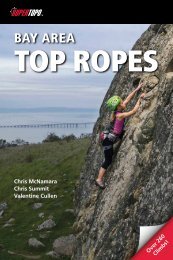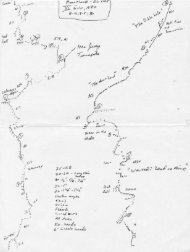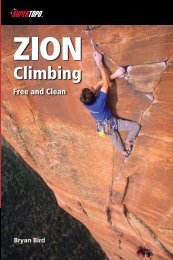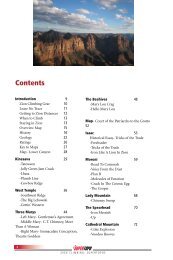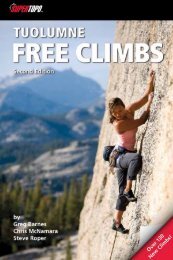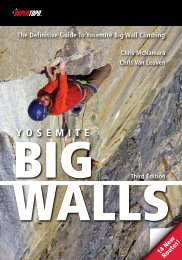You also want an ePaper? Increase the reach of your titles
YUMPU automatically turns print PDFs into web optimized ePapers that Google loves.
The Nose<br />
EL CAPITAN<br />
AS I HAMMERED IN THE<br />
LAST BOLT AND<br />
STAGGERED OVER THE RIM,<br />
IT WAS NOT AT ALL CLEAR<br />
TO ME WHO WAS<br />
CONQUEROR AND WHO<br />
WAS CONQUERED: I DO<br />
RECALL THAT EL CAP<br />
SEEMED TO BE IN MUCH<br />
BETTER CONDITION THAN<br />
I WAS.<br />
WARREN HARDING<br />
Other history<br />
In 1960, Royal Robbins, Tom Frost, Chuck Pratt and Joe Fitchen made the second<br />
ascent of the Nose. This significant ascent, the first continuous ascent of El Capitan,<br />
proved that an enormous wall could be climbed without siege tactics, and it<br />
paved the way for the bold big wall ascents of the ’60s. Jim Bridwell, John Long<br />
and Billy Westbay made the first one-day ascent of the Nose in 1975. Their 15-hour<br />
dash laid the groundwork for the speed climbing that would grip the valley in<br />
later years.<br />
In 1981, Ray Jardine, the inventor of Friends, launched the first major attempt<br />
to free climb the Nose. Just below El Cap Tower the possible free route traversed<br />
30 feet on what Jardine hoped would be 5.11 terrain. He found the moves were<br />
actually much harder, so he used a cold chisel and manufactured 5.11. Jardine’s<br />
motive was his vision of “Numero Uno,” a route up El Cap that was moderate<br />
and accessible to the masses.<br />
In 1993, Lynn Hill approached the climb with a much different philosophy.<br />
After Jardine, many top climbers had attempted to free climb the Nose, but none<br />
was able to unlock sequences on the Great Roof or the Changing Corners. On her<br />
first attempt in 1993, Hill freed every pitch to Camp VI including the Great Roof—<br />
an incredible feat still unrepeated on lead. A few pitches higher on the Changing<br />
Corners pitch, a fixed piton lodged in a crucial finger lock blocked the free ascent.<br />
Returning to the summit a few weeks later with Brooke Sandahl, Hill removed<br />
the offending piton and worked the extremely technical moves. It looked like it<br />
would go!<br />
Hill and Sandahl returned to the base and began their ground up free ascent.<br />
Hill climbed the Great Roof first try and moved to the crux Changing Corners<br />
pitch. Here she employed “a bizarre sequence of moves involving delicate smears,<br />
stems, back-stepping, laybacking, arm bars, pinching, palming, etc.” Again, she<br />
sent the pitch first try and after four days of spectacular free climbing, Hill and<br />
Sandahl stood on the summit. The Nose was free.<br />
It is hard to top one of the great free climbing achievements of all time, but<br />
the next year Hill herself found a way. Starting at 10 p.m. on a September<br />
evening, Hill spent the next 23 hours climbing every pitch free, making the first<br />
one-day free ascent of the Nose.<br />
Strategy<br />
The Nose requires a fast and light strategy. Although many parties climb the<br />
route in more than four days, hauling that much food and water is not pretty.<br />
The route has little mandatory free climbing, but it will be more enjoyable and go<br />
faster if you can free 5.10. The Nose is the most popular route on El Cap, so<br />
prepare to wait in line for two days at the base. Most parties spend the first day<br />
hiking loads to the base and fixing to Sickle Ledge. Fixing gives a head start but<br />
increases the logistics of the climb. If you aim to do the route in two nights, bivy at<br />
El Cap Tower and Camp V. If you are aiming for three nights, bivy on Dolt Tower,<br />
Camp IV and Camp VI. The ASCA and others have replaced almost all lead and<br />
belay bolts.<br />
Retreat/Storm<br />
The Nose is set up for easy bailing from the last pitch all the way to the ground. It is<br />
much easier to retreat from the route with 60m ropes. In a storm the upper part of<br />
the wall, especially Camp VI, receives lots of runoff. Many rescues and a few<br />
deaths have resulted from parties not being equipped with adequate storm gear.<br />
Reference: Sierra Club Bulletin, Vertical World of Yosemite, Camp 4, Defying Gravity, Fifty Classic Climbs of North America,<br />
Big Wall Climbing, Climbing in North America, Downward Bound, 1993 and 1994.<br />
FOR CURRENT ROUTE INFORMATION, VISIT SUPERTOPO.COM




